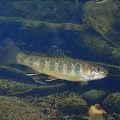“Should I Move or Stay Put?”

photo by Carol Ann Morris
Question: When you’re fishing a pool, pocket, or riffle, how many unproductive casts should you make before you decide to move on to the next spot? And if you catch a fish in one place, should you assume that it has spooked the other fish in the area and move on?
—Mort S.
If deciding whether to abandon a chunk of water or stay and keep working it isn’t the most perplexing decision a new fly fisher must constantly face, it’s got to be among the top one or two percent. Decades ago, I was new to fly fishing and struggled with this too; so, Mort, I sympathize.
Here’s a good general rule: fish a piece of water until it stops putting out fish, and then try the next piece. What’s a “piece of water?” Could be the head of a pool or a section of a riffle in a stream, a fallen log along a shoreline or all the water in front of you that’s within casting range when your boat is anchored in a lake—simply put: some smallish fish-attracting structure or a manageable part of big structure. I know—that’s way too broad to really answer your question, Mort. But we can narrow things down from there as we also explore some caveats.
The History Factor
If you’re certain that the run before you holds a bunch of trout—something you know from having fished this stretch of river dozens of times at this very time of year and under these conditions—you’ll probably start experimenting if six to a dozen presentations of your Royal Wulff move no fish. Next you might watch for insects on or in the surface of the water and match what you find with your flies. But if you see no rises and no real insects to match, you’ll probably next try a smaller or larger or just very different dry fly. Then, if that fails, a nymph. Then a different nymph. Then, if nymphs fail, perhaps a soft-hackled fly….
You know there are trout, so you might as well figure them out here as somewhere else on the river. One thing’s plain at this point: these are persnickety trout. Maybe they’re not persnickety often, maybe only rarely, but regardless, they’re persnickety right now. Better deal with that.
There will come a point though, after a bunch of fly and tactic changes, when you might decide move along. The trout should be there, and according to your experience they should be susceptible to certain of your tricks, but if none of it’s working, why not trade fly and technique variations for variations in holding water? There’s a deep bank just upstream. Maybe if you make a few casts there….
Whole different scenario: What if you know that this water holds only a small number of scattered fish? Then the answer’s easy: Present the fly a few times at each likely spot, and then cover the next spot, then the next. After running the fly through, say, half a dozen spots without action, you’d be wise to consider: Would a change of fly or tactic, or both, do the trick? If you’ve been fishing a dry fly on a trout stream, try a nymph. If you’re fishing a hair bug on a bass pond, try letting a streamer fly sink a bit before working it slowly back.
Virtual History
Knowing about the water you’re fishing can really help you decide how long to stay on one spot even if you’ve never fished a particular stream or lake. Not knowing it firsthand—I mean fly-on/in-the-water wet-boat/wet-boots firsthand—doesn’t mean you can’t know about it. You can ask at the local fly shop (as you purchase a few leaders both as a thanks for the info and to insure the shop’s still around the next time you need it), you can do some research in fishing guidebooks, you can check on-line, you can ask members of your local fly-fishing club what they know. When the information from your various sources matches up, that’s the best. If you read or hear such points as “the largemouth bass in X Lake can be hard to find. Try around the inlet stream” and “the shoal in Lake Y is to the right of the boat launch and that’s where the trout typically gang up” and “don’t bother with the Z River after mid-August—it gets too warm and the fish go downstream and out” repeated various ways, you’ve probably got some solid information. (Though just because you hear something from only one of several sources, don’t rule it out.)
Obviously, how long you stay on a spot fishing the Z River over Labor Day weekend is irrelevant: there are no fish to catch. X Lake is another matter: assuming your intelligence is accurate, you’ll need to do a lot of moving to figure out where bass are currently gathered. See? Your research will help you determine how long to fish one spot before trying another: specifically with X Lake, quite a while around the inlet stream mouth, not long elsewhere on the lake.
Going in Cold
Let’s say you have no history, actual or virtual, no information whatsoever on a lake or stream. Sometimes that’s just the way things go. First, spend at least a full minute (it’ll seem like a quarter hour) just watching. Watching everything, from near your nose to a hundred feet away. Notice everything you can. Do you see the rise of a trout, or not? Do you see insects riding the water or is the top of the river bare? Are bluegills making their smacking sips in and around the weed beds, or not?
Second, read the water; that is, find a spot that likely holds fish: a riffle or a dock or a boulder field or whatever your target fish likes. Of course if trout or panfishes or smallmouth bass are rising, or largemouth bass are splashing at dragonfly adults, then you don’t need to find fish: there they are.
Third, approach with stealth—you have no idea yet how spooky these fish are or are not.
None of this really addresses the matter of how long to stay on a spot, but it will. Now, in fact. Let’s say trout are rising; well, just go to work on them. And keep working on them until there are no more rises within comfortable reach. Then make a few test casts and, if nothing happens, move on. Let’s say smallmouths are rising to mayflies hatching on a river—same deal: fish until the action dies, a few test cast, move. Bluegills showing in the shallows? Also, same deal.
But suppose the fish clearly are there yet you can’t get them to take anything? Perhaps they are feeding on top, or you can see them gliding or holding down in the clear water (or you just know they’re there because you know this water well). That’s really up to you. You can give them some time and experimentation and then go on and try some new fish. That might work. I usually just keep working a fish, changing flies and tactics, until I hook him or I run out of time. Or, sometimes, if I grow tired of his attitude, which takes quite a while—I love the challenge of fish stubborn, cagey, or both.
Another common Scenario: zero trout are rising and no bugs are appearing on the river. Try something logical, general—see if they’ll come up to a Parachute Adams. If they won’t, try another spot, if that spot or the next one or two produce nothing, it’s time to try various flies and methods on the assumption the fish are there but aren’t liking what you’re offering. Assumptions are what you have to make when you’ve got no clues. Same for smallmouths, bluegills, whatever: find a promising stretch of water, fish a likely fly, after a while try more water but with various flies and methods. Just makes sense, doesn’t it, Mort?
So how long is “after a while?” I usually wait until I’ve presented a fly six to a dozen times before I figure nothing’s going to happen. At least with a floating fly (dry fly, hair bug, etc.). I might make more presentations with a nymph in a trout stream or a streamer in a smallmouth lake—that is, with a sunken fly—because getting the depth and retrieve right may take some fussing. Still, two dozen presentations in this case should be plenty.
***
That’s really about it, Mort: knowing when to leave a patch of water for the next patch is always a game of chance. Done best, it’s a blend of experience, logic, foreknowledge, instinct. No matter how it’s done, it always includes some degree of luck. At the high end of the luck scale is accidentally picking that just-right fly or depth on the first try, or finding fish where they really shouldn’t be because on a whim you tossed your fly there as you passed by, and so on. But even though luck can be a lifesaver, you’re wiser to rely mainly on what you learn and hone over lots of time spent on the water.
So get to know a stream or lake, Mort, keep returning to it, and eventually you’ll have developed a strong sense of how long to stay in one place and how many flies and techniques to try before you leave it for the next place. Then you can apply all that understanding and experience to waters you don’t know.











